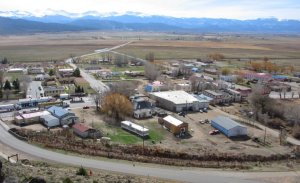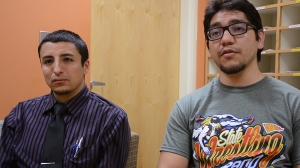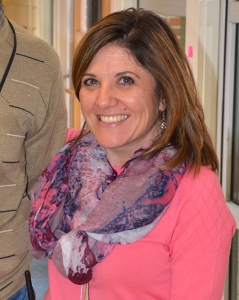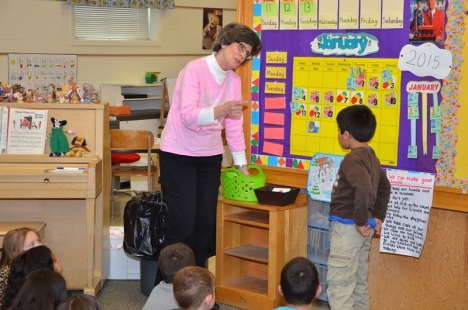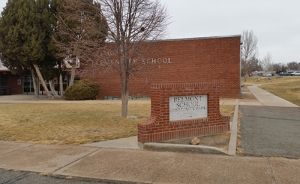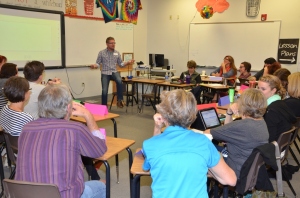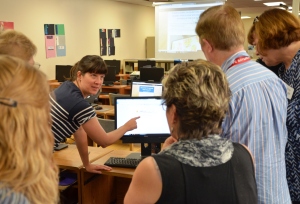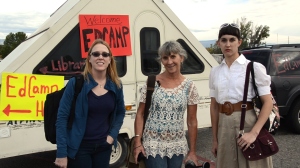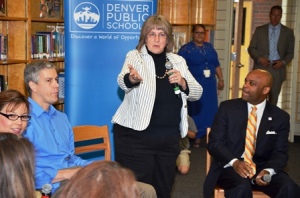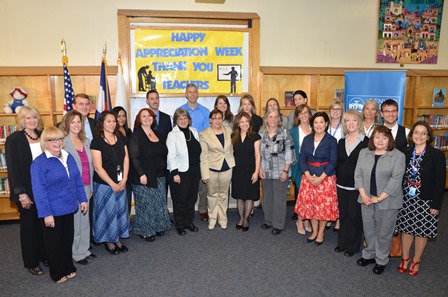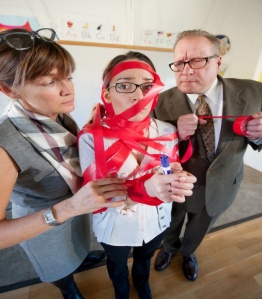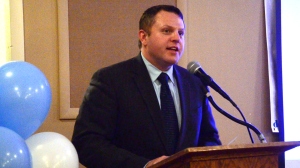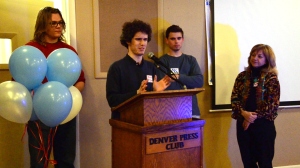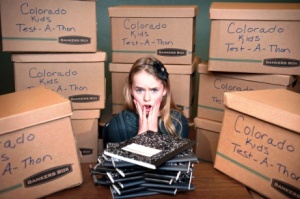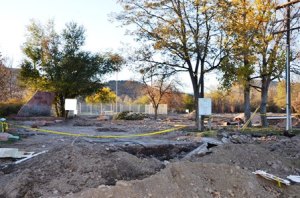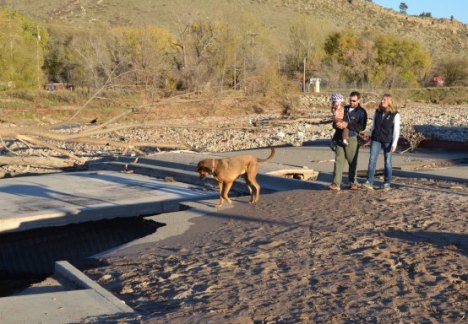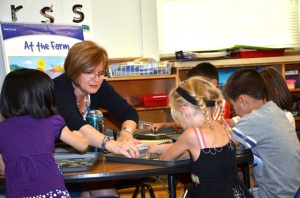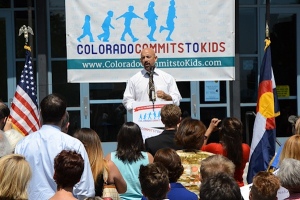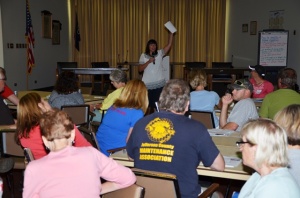Education is a people business. Away from they hype around curriculum and test scores, the success of an educator often hinges on the strength of personal connections made with students and their families.
“These are our students, our children. We’re more than just a teacher when we’re at school,” said Mark Bruemmer, a teacher of construction trades and information technology at Greeley West High School. “Students come to school to have some of that safety, some of that support, some of that comfort.”

The Army evacuates residents of Drake two days after the heavy rains hit (photos from Bruemmer family).
A sense of safety, support and comfort were all in short supply across northern Colorado on the evening of Sep. 11, 2013, when torrential rains pounded the region and unleashed powerful floods that destroyed homes, bridges and roads. Two of Mark’s students still don’t have a place to call home.
“These two students, I’ve definitely pulled in and said, ‘Hey, I don’t know what you’re going through, but let me know if you need something. We can put something together for you,’” said Mark. “They have nothing. Their backpacks, their notebooks – everything is gone.”
Mark knew what these students needed first, because his family needed it too – the gift of time. He gave the students as much time as they needed to get caught up and get family life back in order before worrying about school work.
“And that was very similar to my family as well, and what we received from the administration here – ‘let us know what you need.’ I needed time off to chat with FEMA. I needed time off to figure out where we were going to live. I need some time to process all of this. That’s very similar to how I reacted to what these students potentially needed.”
The rain was coming down pretty hard when Mark and his wife Sarah, also a teacher at Greeley West, made the hour drive home on Sep. 11, west along Highway 34 to the mountain town of Drake. Later at home, the Bruemmers learned the highway had closed, but authorities were letting people drive out of the area. Mark decided to ride the storm out at home. “I didn’t want to be that person who was driving out and never seen again,” Mark laughed.
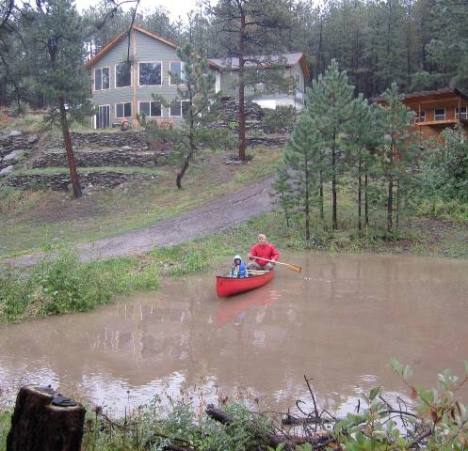
Mark and Lily go canoeing in their soaked neighborhood.
“That first day (Thu, Sep. 12) it rained like crazy,” Mark recalled. “It kept raining, coming down, sheets of rain. It sounded like hail on the roof, even though it wasn’t hailing, it was coming down so hard.”
The rain let up in the afternoon and Lily, his 5-year-old daughter, asked to go canoeing in the new lake outside.
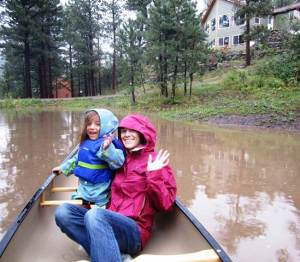
Lily and Sarah are all smiles as the Bruemmers plan to ride out the storm.
“We took the canoe out, hopped into our little pond and paddled around a bit and made some light of the situation, still again thinking things are okay and we’ll get out eventually,” Mark said. “We might be stuck here for a week or two, but we had enough supplies to survive up there.”
But the rain was still coming down Friday as the Bruemmers monitored the situation at home on the Internet. They found roads were starting to disappear everywhere.
“We drove down that morning and looked at the destruction of our little bridge to get across to Road 43, and it was almost gone. The roadway was gone,” Mark said. “It was just magnificent – the power of the water. And we knew it was more serious.”
Back at home, Mark found the Internet and phone service had died. He also saw an Army Chinook transportation helicopter landing in the distance and went over to ask questions.
“They mentioned they had three helicopters coming and that might be the only trip out for quite some time,” Mark recalled. “Our daughter was running a fever – we need to get out of here.”
Mark and Sarah each loaded a hiking backpack, packed tightly with laptops, business supplies and anything else that would fit.
“I brought a few items of clothes, but thought, what an opportunity to wear shorts and t-shirts to work. I can be casual every day and nobody’s going to argue with me for at least a few weeks,” Mark said with a grin.
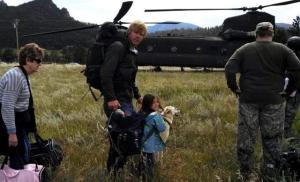
Mark and Lily, ready to climb aboard, though not sure where they’re going.
Lily picked one stuffed animal and a blanket. “She was trying to figure out what was going on, and I had to yell, ‘We need to get out of here now – go! Get your stuff, we’re leaving!’ Lily handled it really well. She wasn’t afraid,” Mark said. “We got to talk about the excitement of riding in a helicopter – ‘hey, this is kind of cool.’”
The Bruemmers and their neighbors left Drake on the second helicopter.
“Yeah, it was pretty wild. I’d never flown in a helicopter before. I was a little curious, pulled one earplug out and I was not very happy that I did that. They’re pretty damn loud, so I put the earplug back in.

On the Army Chinook, evacuating to Fort Collins.
“Our daughter was pretty brave about it,” Mark continued. “She thought it was pretty cool that she got to ride in a helicopter. She definitely told a lot of people about this helicopter ride.”
Mark built their home in Drake and left knowing it would hold up well to the storm. “I wasn’t too concerned about leaving the house other than the fact that we have two backpacks and we’re leaving – now what?”
The helicopter took the Bruemmers and other families to Fort Collins, where they were bused to a church in use as a Red Cross evacuation center.
“That was really humbling,” Mark remembered. “There we are with a couple of backpacks, our only belongings, and people are feeding us like we’re kings and queens. I had a fresh hamburger, they gave us a full-baked pie. Life was pretty good for a few moments there, but we had no clue what was going to happen next.
“What the heck do you do?,” Mark wondered. “It was a little surreal at that point. We were evacuees.”
The Bruemmers arranged to stay with another teacher’s family for a couple of nights, then moved in with Sarah’s father for the next month. The Greeley Tribune ran a profile story on the Bruemmers, and from that attention, a couple who lives in Arizona for the winter offered their house to the family. It’s been a place to call their own while they keep a watchful eye on their home back in Drake.
Many residents stayed in Drake for the long haul and Mark gave the house code to a few people who check on things occasionally. Mark and a friend even made a 16-mile hike up to Drake to winterize the home and grab some more items. So far, so good.
“We have nothing to lose at this point. It’s just things,” Mark said of what they left behind. “We have each other. We have a few of our necessities that we like. There’s a few more necessities that would make life more comfortable, but they’re things.
“We’re not too concerned,” Mark continued. “We’re going to get back home. This is a temporary situation for us, fortunately not permanent. We have a home that’s intact and so do our neighbors.”
Mark and Sarah were back at Greeley West the following Tuesday, Sep. 17. “We felt it was necessary to be back. The students needed us there, they had questions,” Mark said. “Our students rely on us every day to be here, so that was huge for us.”
The Bruemmers showed their students a slide show of their adventure, but that was it for the past. Both teachers were eager to keep their students, and themselves, moving forward.

Mark Bruemmer at his construction trades class at Greeley West High.
“Day one I think my students just thought I was going to step in, chat about how the flood was,” Mark said of his construction trade class. “They asked, ‘Are we going to do something in here today?’ Absolutely. I’m your teacher, I’m here. Learning still needs to happen. Yeah, so I don’t have a home to go to for a while. Whoop-de-ding. We still need to be in here, we still need to be working,” Mark told his students.
The ordeal even brought something new into the classroom instruction – how to build a floodplain.
“I thought that was appropriate for some of the students down here, in addition to what I was going through, just to touch upon there is building code revolving around building in a flood plane and what that looks like,” Mark said. “It was one of those teachable moments.”
The Bruemmers greatly appreciate assistance from the school and the community. They’ve received offers of places to stay as well as gift cards for fuel, groceries and clothing.
“I really appreciate all the outreach from folks, our local union definitely.” Both Mark and Sarah are members of the Greeley Education Association. “Our local president, Pat Otto, was on the phone right away – ‘Do you need anything? What can we do for you?’ I’ve had a lot of support.
“That’s why you’re an educator. Everybody is here to help each other,” Mark added. “That’s why we’re here. We’re here to take care of each other. I really do appreciate that. It made it a lot easier to be displaced.”
Mark still checks in on his students, especially the two who are also displaced, making sure they have supplies and support. He perceives things are going alright for them under the difficult circumstances.
“They’re smiling every time they’re in class, so I’m hoping that they’re being taken care of as well as they need to be taken care of, if not better.”
Filed under: Public Education, Teacher Profiles, Teaching and learning conditions | Tagged: "Colorado flood", CEA, Colorado Education Association, Drake, Greeley, Greeley West High School, Mark Bruemmer | Leave a comment »





